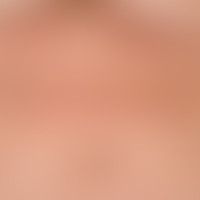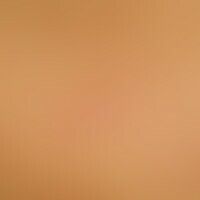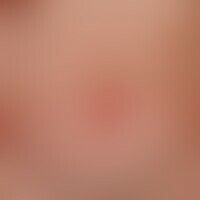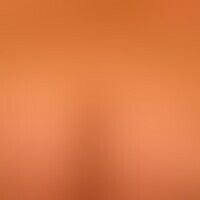Image diagnoses for "Nodules (<1cm)", "red"
261 results with 813 images
Results forNodules (<1cm)red

Contact dermatitis allergic L23.0
Pronounced. large-area allergic contact eczema: large, blurred (scattered edges), itchy, red, rough, scaly plaques that have existedfor 4 weeks.

Sweet syndrome L98.2
Dermatosis acute febrile neutrophils: acute, exanthematic clinical picture with affection of face, neck, trunk and extremities; here detailed picture of the lower leg with red, succulent papules and plaques.

Acne (overview) L70.0
Acne papulopustulosa: disseminated follicular inflammatory and non-inflammatory papules, pustules and retracted scars; recurrent course.

Early syphilis A51.-
Syphilis Early syphilis: discreet , non-itching or painful, maculo-papular palmar syphilis

Dyskeratosis follicularis Q82.8
dyskeratosis follicularis. presentation of multiple, chronically stationary, disseminated, red nbis rfot-brown papules localized in the submammary and upper abdomen. in these areas strong increase of skin changes, especially in summer with increased sweating.

Folliculitis barbae L73.8
Folliculitis barbae: Eminently chronic therapy-resistant (no significant improvement under systemic antibiosis), folliculitis of the child and neck

Keratosis lichenoides chronica L85.8
Keratosis lichenoides chronica: Generalized exanthema of scaly, lichenoid papules in a linear arrangement.

Tinea faciei B35.06
Tinea faciei. multiple, chronically active, since 4 weeks flatly growing, disseminated, 0.5-3.0 cm large, blurred, itchy, red, rough (scaling) papules and plaques as well as few yellowish crusts

Porokeratosis superficialis disseminata actinica Q82.8
Porokeratosis superficialis disseminata actinica: Disseminated, reddened, marginalized papules up to 0.5 cm in size on exposed skin areas.

Dermatitis herpetiformis L13.0
Dermatitis herpetiformis. multiple, disseminated standing, itchy, scratched excoriations on the right arm of a 15-year-old patient. the scratched excoriations are located at sites where grouped vesicles had appeared a few days before. overall, the disease has existed for several months and shows a chronically recurrent course.

Granuloma anulare disseminatum L92.0

Tinea inguinalis B35.6
Tinea inguinalis: plaques that have existed for several months, coarse lamellar scaling and moderately itchy. Mycological evidence of T. rubrum.

Acroangiodermatitis I87.2
Acroangiodermatitis. detail from the above figure. 0.2-0.4 cm large, initially isolated, then aggregated, deep red to reddish-livid papules develop from the smallest red (haemorrhagic) spots with a smooth surface, which finally confluent to form large plaques.

Lymphomatoids papulose C86.6
Lymphomatoid papulosis: Patient, 73 years of age. Within a few days a red, solid nodule appeared on the nasal wing. In the biopsy atypical dermal infiltrates with CD30-positive blasts. Within a few more days multiple similar nodules spread over the upper trunk.
At control 8 weeks after initial diagnosis the nodule at the nasal fossa is completely regressive leaving a milieu, but a new nodule 5 mm further cranially. The nodules at the trunk are regressive.

Glossitis rhombica mediana K14.2

Acne excoriée L70.8

Papillomatosis cutis lymphostatica I89.0
Papillomatosis cutis lymphostatica:large-area, distally sharply defined, proximally tapering, coarsely indurated, large-area, verrucous plaque with smaller nodules; condition following recurrent erysipelas.







